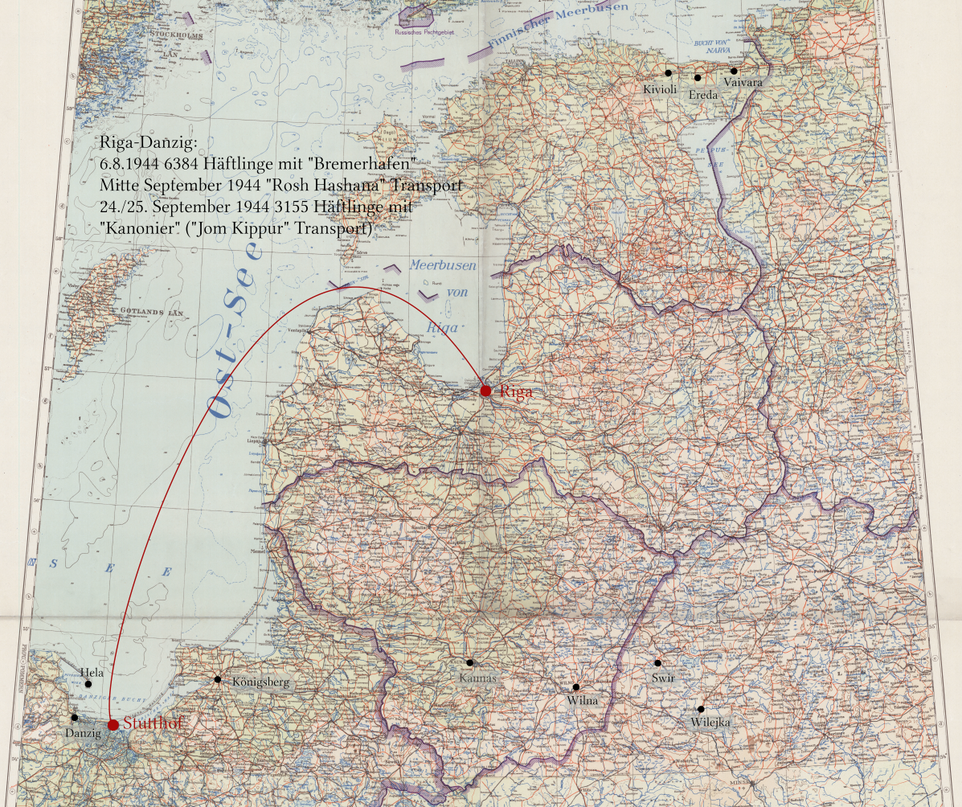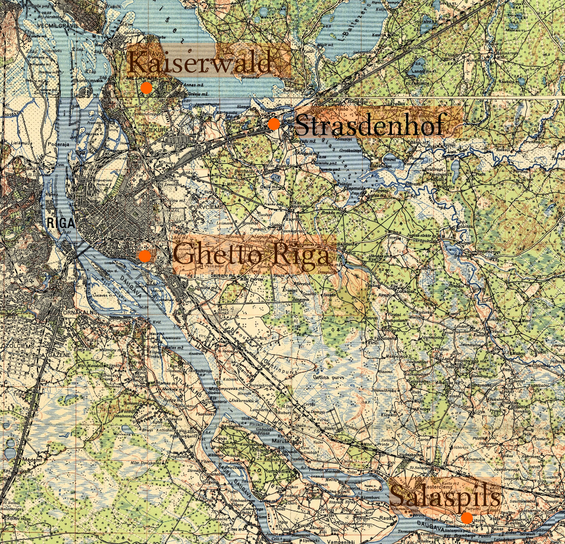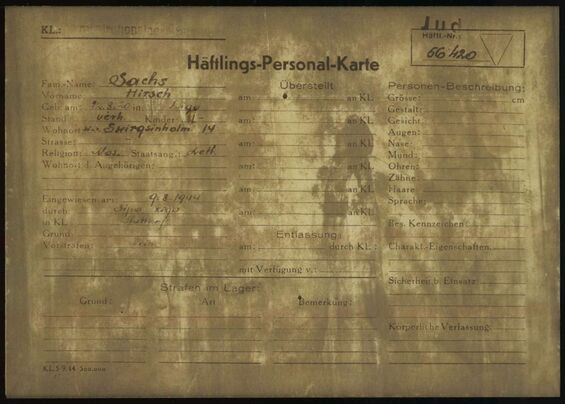The Biography of Zwi Hersch Zaks, Riga
Short biography and stations of his persecution
- Born on 22 august 1920 in Riga/Latvia.
- 1926-1934 elementary school/grammar school, locksmith
- arrested July 1941, Riga ghetto
- October 1943 Riga-Kaiserwald concentration camp
- 9 August 1944 Stutthof concentration camp
- September 1944 Stutthof concentration camp/Stolp subcamp
- 3/1945 Stutthof concentration camp/Lauenburg subcamp
- 4/1945 Stutthof concentration camp
- 4/25/1945 Transport to Neustadt/Holstein
- 3/5/1945 Neustadt liberation
- DP camps Neustadt, Hamburg-Blankenese
- 1948 Israel
Zwi Zaks lost his parents, three sisters and a brother.
Life before Persecution
Before the war I lived in Riga; I was a locksmith by trade; my father was a merchant. I lived on Zvirgden (an island in the city).
affidavit 1954
When questioned, the claimant (KL) stated that he was born in Riga [...] His parents and his five siblings had already perished in November 1941. [...] His father was a real estate agent by profession and had a good income; his mother ran the household and was not employed. [...] He attended elementary school until he graduated, he was a good, but not exactly outstanding student. He did gymnastics and sports at school. After finishing school, he became an apprentice locksmith, later successfully passed his journeyman's examination and then worked as a journeyman locksmith. After the occupation of Latvia by the Russians (1940), he had to join a locksmith's collective, as private companies were banned.
Specialist psychiatric court report. 27.8.1969
Riga Ghetto/Riga-Kaiserwald
A ghetto was set up in Riga in July 1941. I lived temporarily at 85 Ludzas Street and worked in the Grossheeresbaudienststelle 1. The ghetto was fenced in with barbed wire and guarded by the SS. I wore the Jewish star on my chest and back. Every day I was guarded and walked about 2 km to work in Merkelostrasse. - In October 1943 I was sent to Kaiserwald concentration camp and from there after 3 days to Kaiserwald- Deutsche Reichsbahn. The camp was fenced in with barbed wire and guarded by SS. I wore prisoner clothes with the prisoner number 7517, lived in a barrack and worked at the railroad works. The camp was in the railroad works. -
Source: Affidavit Zwi Zaks, 1954, Staatsarchiv Hamburg, Sig. 213-13_3575
In July 1941 we came to the Riga ghetto, I lived at Wilanustr. 14, he at Ludzas 85. We worked at the Grossheeresbaudienststelle 1, I at M.V.A. The ghetto was fenced in with barbed wire, guarded by SS. We wore Jewish stars on our chests and backs. In Oct. 1943 we came to Kaiserwald, in Dec. 1943 we came to Kaiserwald-German Reichsbahn, the camp was fenced in with barbed wire, guarded by SS. We wore prisoner's clothing, with H.-Nr. He had H.-Nr. 7517, I had H.-Nr. 611, we worked together at the railroad works, we lived together in a barrack. We stayed there until 6.8.1944 and were then sent to Stutthof,
Source: Testimony David Jakobsohn, born 13.6.1913 in Riga, 1954, Staatsarchiv Hamburg, Sig. 213-13_35754
When the German-Russian war broke out in 1941, the applicant was living with his family in Riga. He was immediately arrested, as were all the other young people, and was then forced to work for the Germans in Riga. Later, the ghetto was opened, the family was transferred there and claimant was also taken from there to work until the ghetto was liquidated a few months later. On this occasion, claimant lost his entire family, he himself joined a working group of experts and was taken to a forced labor camp. He had to perform various services for the Wehrmacht. In 1943, he was sent to forced labour camp Kaiserwald, from where he was soon transferred to the Reichsbahn as a locksmith. claimant worked there until 1944 and was then taken by ship via Stutthof and Danzig to Neustadt in Holstein, where he was liberated by the British on May 3, 1945.
Medical certificate, July 1965
During forced labor at the Reichsbahn in Riga, he suffered a work accident due to a defective pulley. Fell head first into a shaft and broke his right collarbone. Collarbone broken. Also cuts on his hands, especially on the right. Continued to work in an emergency bandage and in great pain to avoid being sent back to Kaiserwald for liquidation.
Expert opinion 14.4.1965
Stutthof, Stolp, Lauenburg
In August 1944, I was transported by ship to Stutthof concentration camp, which was fenced in and guarded by the SS. There I was given the prisoner number 56420 and wore prisoner's clothes. I did camp work and lived in barrack no. 13. - I was sent to ZAL Stolp in September 1944. It was fenced in with barbed wire and guarded by SS. There I wore the same prisoner number and prisoner clothes and continued to work at the railroad works. - In March 1945 I was sent to ZAL Lauenburg b/Danzig. The camp was fenced in with barbed wire and guarded by SS. I had the same prisoner number and prisoner clothes. I worked there building bunkers. After about 2 weeks I returned to Stutthof concentration camp and worked in the Steige satellite camp building bunkers. Every day I was led to work under guard, about 3 km on foot, and wore prisoner clothes and a prisoner number. The camp was guarded by SS and fenced in with barbed wire. -
Source: Affidavit Zwi Zaks, 1954, Staatsarchiv Hamburg, Sig. 213-13_3575
We stayed until August 6, 1944 and then came to Stutthof, where he was given the H.-No. 56420, I had the H.-No. 56611. The camp was fenced in with barbed wire, guarded by SS. We wore prisoners' clothing, worked in the railroad works, in March 1945 we went to Lauenburg together, lived in neighboring barracks, worked building bunkers, after about 2 weeks we came back to Stutthof, we stayed there until April 25 and were evacuated by boat to Neustadt-Holstein, where we were liberated on May 3, 1945.
Source: Testimony David Jakobsohn, born 13.6.1913 in Riga, 1954, Staatsarchiv Hamburg, Sig. 213-13_35754
| Concentration camp Stutthof | ||
|---|---|---|
| Location | Sztutowo / Stutthof | |
| Area | Reichsgau Danzig-West Prussia (1939-1945), Free City of Danzig | |
| Opening | 01.09.1939 as a civilian prison camp; continued as an SS special camp from 05/13.11.1941; name changed to concentration camp from 13.01.1942 | |
| Closure | "Evacuation" from 25.01.1945 in the direction of Kdo Lauenburg. The prisoners still remaining in the camp were evacuated by ship via the Hela peninsula in the last third of April 1945 | |
| Deportations | ||
| Prisons | In total, around 110,000 people from 27 European countries and the USA passed through the Stutthof camp between 1939 and 1945. It is estimated that 65,000 people did not survive the camp and the "death marches". [LIT] | |
| Gender | Men | |
| Type of work | Work in agriculture, | |
| Comments | Labor education prisoners were also housed in Stutthof concentration camp | |
| Marking | ||
| Source: deutschland-ein-denkmal.de | ||
| Subcamp of the Stutthof concentration camp | |
|---|---|
| Location | Słupsk / Stolp |
| Name | |
| Area | Prussia (Province of Pomerania) |
| Opening | August 26, 1944 |
| Closing | March 1945 ("evacuation"), liberated on 03.05.1945 in Neustadt/Holstein |
| Deportations | |
| Prisons | A total of 650 male and female prisoners |
| Gender | Male |
| Assignment of prisoners at | |
| Type of work | Work in a wagon repair workshop |
| Source: deutschland-ein-denkmal.de | |
"Evacuation" and Liberation
- On April 25, 1945, I was evacuated and taken to Neustadt-Holstein, where I was liberated by the British on May 3, 1945. -
Source: Affidavit Zwi Zaks, 1954, Staatsarchiv Hamburg, Sig. 213-13_3575
We stayed there until April 25 and were evacuated by boat to Neustadt-Holstein, where we were liberated on May 3, 1945.
Source: Testimony David Jakobsohn, born 13.6.1913 in Riga, 1954, Staatsarchiv Hamburg, Sig. 213-13_35754
The liberation in Neustadt was preceded by a gruesome tragedy. Dr. Goldschläger's report contains only the few words "was then taken by ship via Stutthof and Danzig to Neustadt in Holstein, where he was liberated by the British on May 3, 1945".
These few, harmless-sounding words were enough to show me that client was one of the relatively few survivors of one of the most appalling misdeeds committed by the Nazis in the last days of their collapsing rule. I knew this gruesome story very well, as I had heard it from three or perhaps four people, all women, who had been assessed for damage to their health in the course of my work as an expert witness over the course of several years, and always in almost the same words. Of course, I had to strictly avoid suggesting to the client the story I already knew; I therefore told him that I had already heard about this evacuation by sea from other assessors, but that I would like to hear it again from him. Kl, who until then had been psychologically very inhibited, now became emotional, his emotional state broke through his inhibitions, and he spoke vividly and with great excitement about this "sea voyage", and something else surprised me: his wife, who had probably not yet been his wife at the time, had also taken part in this transport. She, too, who had been sitting there quietly until then, became animated and became very emotional. The story of this "sea voyage", as I had heard earlier from three or four people I had examined, and now heard again from Mr. and Mrs. Zaks, is as follows: When the Russian army approached, the prisoners were evacuated from Stutthof to Danzig and there "packed" into 6 barges, in which they sat or stood squeezed together like sardines; the deck of the barges was closed off, but it seems that the inmates got some daylight through the narrow hatches and also some fresh air when the sea was calm. The tug and tow was towed from Danzig to Neustadt (Holstein) in about six to seven days. There was nothing to eat or drink. The thirst became unbearable, so that the unfortunates drank their own urine until the urine secretion dried up. It seems that some managed to draw seawater through the hatches, but in the western part of the Baltic Sea - between Rügen and the Holstein coast - the water already had a salt content that made it undrinkable. A large number of the prisoners died of thirst, hunger and suffocation during the journey in the insufficiently ventilated room, which was filled with the fumes of the prisoners and their excrement, as well as the corpse odor of the deceased. After six or seven days of travel, the train approached the port of Neustadt, unfortunately just as the British vanguard reached Neustadt. The British suspected a German landing attempt and opened fire on the tug. The German crew of the tugboat threw off the tow rope and the steamer made off, while the barges were driven onto the beach by the wind and waves. The prisoners managed to open the deck hatches of the barges and all those who were still able to do so jumped overboard and waded or swam to the shore. The British realized their mistake and stopped firing, but the crew of the tugboat opened fire on those wading and swimming. Many of the prisoners fell victim to the fire of the British and then the Germans. The British took the completely exhausted survivors to the Neustadt country hospital, which they had confiscated for this purpose.
Source: Expert opinion by Dr. Kauffmann, 1969
After the Liberation
After the liberation I was in the DPL Neustadt-Holstein until May 1946, then from 1946 to 1948 in the DPL Hamburg-Blankenese and lived in the Warburg-Kinderheim, Kostenbergstrasse 58. I had an index card and registered with UNRRA on January 1, 1947. I worked in the guard service and as a kitchen assistant the whole time. I married Margit Ehrlich at the registry office in Hamburg-Blankenese in 1948 (early). - In 1948 I emigrated to Israel; now I have 2 children, am a worker and have no assets. I lost my parents, 3 sisters and 1 brother. ....
Source: Affidavit Zwi Zaks, 1954, Staatsarchiv Hamburg, Sig. 213-13_3575
We were liberated together in Neustadt-Holstein in May 1945. After liberation, we were both in the D.P. camp in Neustadt-Holstein until 1946 and from there we were sent to the D.P. camp in Hamburg-Blankenese children's home, where we stayed until the end of April/beginning of May.
On January 1, 1947, we were both in the Blankenese D.P. camp, registered with UNRRA and looked after by them. We both lived in the children's home at Kostenbergstrasse 58 and worked together in the kitchen. Zaks Zwi also worked as a guard. In 1948 we emigrated to Israel together with the S/S "Transsilvania".
Source:Testimony Roza Roelen, geb. Ekstein, geb 26.5.1910 in Panticeu/Rum, Staatsarchiv Hamburg, Sig. 213-13_3575
Notes
Further Sources
Stattsarchiv Hamburg, file Zwi Zaks, Staatsarchiv Hamburg, Sig. 213-13_3575
Office for Compensation
Hamburg EG 2208.20/13
Notes
- Transportdaten Riga-Danzig: THE UNITED STATES HOLOCAUST MEMORIAL MUSEUM ;
Encyclopedia of CAMPS AND GHETTOS, 1933–1945, VOLUME I, Part B, S. 1232 - Killing of Jews in Riga: " In two large-scale Aktions on November 30 and December 8, 1941, more than 24,000 Latvian Jews from the Riga ghetto were
murdered by German and Latvian police. " THE UNITED STATES HOLOCAUST MEMORIAL MUSEUM ;
Encyclopedia of CAMPS AND GHETTOS, 1933–1945, VOLUME I, Part B, S. 994
Picture Credits
- "Übersichtskarte Baltische Länder Interessengrenze", Zusammendruck Maßstab 1:1 000 000, 1941, "Hergestellt im Auftrage Gen St de H Abt f Kart u Verm W", Quelle: mapster
- Karte Riga, lithuanianmaps.com
- Hirsch Sachs, Häftlingspersonalkarte 1.1.41.2/4622190/ITS Digital Archive, Arolsen Archives
- Hirsch Sachs, Häftlingspersonalkarte 1.1.41.2/4622191/ITS Digital Archive, Arolsen Archives




